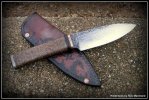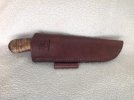You are using an out of date browser. It may not display this or other websites correctly.
You should upgrade or use an alternative browser.
You should upgrade or use an alternative browser.
Question for you leather craftsman
- Thread starter nikosia7
- Start date
- Joined
- Jun 13, 2007
- Messages
- 7,743
Question: Can an already created and stained sheath be re-tooled and portions restained a different color? Thank you-Tom
Re-tooled? Are you referring to stamp tooling like a basket weave stamp, a design cut with a swivel knife or do you mean something else? You can re-dye a darker color, but the original color will likely have an influence on the final result unless you are dyeing to black.
A picture of the sheath would be greatly helpful, but if it's a (non wet formed) plain sheath that you want to disassemble and reuse the leather from, it can probably be done.
Hi Strigamort. Thank you for the response. I'm not ready to make a sheath on my own just yet so I thought I would try making changes to this one. My plan was to put a mottled finish in some areas and dye with a darker color. In addition, I wanted to add a few copper rivets. Would I use a swivel knife to create the mottled finish? What brand dye would you recommend? Sorry really know very little in regard to leather work. Thanks. Attempting to attach a photo of the sheath now.
- Joined
- Jun 13, 2007
- Messages
- 7,743
Hi Strigamort. Thank you for the response. I'm not ready to make a sheath on my own just yet so I thought I would try making changes to this one. My plan was to put a mottled finish in some areas and dye with a darker color. In addition, I wanted to add a few copper rivets. Would I use a swivel knife to create the mottled finish? What brand dye would you recommend? Sorry really know very little in regard to leather work. Thanks. Attempting to attach a photo of the sheath now.
Try looking at threads that cover custom dyeing in this forum. There are a couple that I'm aware of recently. The best mottled job that I've done was by accident. I had spent some time making everything nice and two toned (black and green). When I went to wet form the colors ran together and looked nice. Mottled can mean very different things to different people though.
A swivel knife is used to cut designs into veg tanned leather. Other tools are used in conjunction to achieve work like scrolling, plants and roses, western scenes, animals, etc.
To add copper rivets you'll need the rivets and tools to set them. Tandy, I believe, has what you need. I don't bother myself as I've found contact cement and waxed thread to be more than sufficient in terms of durability, although there may be some use for them in extreme situations. I believe they are probably used most often for ease of manufacturing or looks.
As far as I've seen Fiebings leather dye is the overwhelming choice for dyeing leather. I've tried their spirit based dye and their pro "oil" (not really oil) based dye and I'm switching to the oil based. Great stuff.
Other choices for dye are Tandy's Eco Flo water based dye (I won't be using this stuff) and Angelus products. I'm sure there are others but I'm not aware of them.
Good luck and let me know if there's anything else I can help you with.
Thanks Strigamort! I'm going to attach a photo of the "mottled" look I'm going after. It's a sheath made from a maker on this forum (quite the artisan craftsman). The copper rivets would be purely for aesthetics. In addition, I'm interested in a hemp or bank line wrap to cover the pathfinder logo and for practical use as needed. Nothing against the pathfinder school logo just wanting to create a look and practical use in one. Maybe something similar to the handle wrap in the photo I'm posting. Really not sure how to treat the hemp etc. thanks again!

- Joined
- Jun 13, 2007
- Messages
- 7,743
I hate to admit it but I've been trying to figure out how that texture is done. I can replicate it using certain rocks, but I've not found a practical tool made just for that look. The dye may be antique dye or a combination of antique and regular dye. Antique is made so that you rub it into a texture then wipe off. It's made thicker than regular dye (like a gel) and doesn't dye nearly as quickly. Once wiped off you have the dark color in any recess (be it cut, stamped or otherwise) and a lighter color (typically brown) on the level surfaces. Others can correct or add to this, but that's how I use antique. How that sheath was treated specifically I'd like to know as well.
The wrap on your knife is most likely resin impregnated. Very rarely have I seen a knife that was cord wrapped (other than para cord) and not treated with an epoxy resin. If you are simply going for a look the hemp should work, although as you've pointed out, you'll need a way to secure it. If it's purely for function, para cord is very hard to beat. You probably know this, but para cord is kernmanttle meaning it's a sleeve with inner strands. That fact alone makes it a fantastically useful material. Being nylon also contributes in that it can't mildew like a natural fiber can. Para cord bracelets and what not may be (or have been) a fad, but that takes nothing away from its real world value.
Yes, that type of rivet can be done in a couple of ways. First you need the rivets. Those are really inexpensive. They are a two part stem and washer. I recommend you buy the longest stem because you can trim them easily for shorter needs. There is a tool that is used to press the washer down, then on the same tool there's a recessed area that domes the pin over the washer. If you're handy it can be done fairly easily without the setting tool, but it will make things easier and will likely look better.
Can someone comment on how that exact finish might be achieved?
The wrap on your knife is most likely resin impregnated. Very rarely have I seen a knife that was cord wrapped (other than para cord) and not treated with an epoxy resin. If you are simply going for a look the hemp should work, although as you've pointed out, you'll need a way to secure it. If it's purely for function, para cord is very hard to beat. You probably know this, but para cord is kernmanttle meaning it's a sleeve with inner strands. That fact alone makes it a fantastically useful material. Being nylon also contributes in that it can't mildew like a natural fiber can. Para cord bracelets and what not may be (or have been) a fad, but that takes nothing away from its real world value.
Yes, that type of rivet can be done in a couple of ways. First you need the rivets. Those are really inexpensive. They are a two part stem and washer. I recommend you buy the longest stem because you can trim them easily for shorter needs. There is a tool that is used to press the washer down, then on the same tool there's a recessed area that domes the pin over the washer. If you're handy it can be done fairly easily without the setting tool, but it will make things easier and will likely look better.
Can someone comment on how that exact finish might be achieved?
- Joined
- Jun 13, 2007
- Messages
- 7,743
Pick up a bottle of brown antique while you're there. It's probably what they used on that sheath. I'm not sure how they got the impressions, but mimicking it should be fairly simple.
Good luck.
Good luck.
- Joined
- Jun 13, 2014
- Messages
- 16
the answer is yes to both questions just a matter of using the right chemicals/deglazer/ solutions to lighten the leather
then moisten and tool as you like then redye or texture using more chemicals/dyes/solutions and grits to texture.
you are only limited by your imagination and the knowledge of chemicals, natural and synthetic.
then moisten and tool as you like then redye or texture using more chemicals/dyes/solutions and grits to texture.
you are only limited by your imagination and the knowledge of chemicals, natural and synthetic.
- Joined
- Jun 13, 2007
- Messages
- 7,743
Funny, I was just thinking about this thread a little while ago. Lightening a color should be possible with oxalic acid.
I've been reading up on some techniques and it appears that texture can be pressed into the leather (probably wet) with something like 40-80 grit sandpaper (thanks Gary!), or a stippling tool.
Techniques with antique dye is all over the place. My plan next time I use it is to try a dye then an acrylic sealer then antique on top followed by another coat of sealer.
10,000 ways to skin a cat, if a cat were every single step in leather work. Everyone has their own way of doing everything, just gotta figure out which work best for you, and by you, I mean us.

I've been reading up on some techniques and it appears that texture can be pressed into the leather (probably wet) with something like 40-80 grit sandpaper (thanks Gary!), or a stippling tool.
Techniques with antique dye is all over the place. My plan next time I use it is to try a dye then an acrylic sealer then antique on top followed by another coat of sealer.
10,000 ways to skin a cat, if a cat were every single step in leather work. Everyone has their own way of doing everything, just gotta figure out which work best for you, and by you, I mean us.

